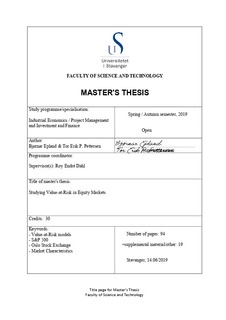| dc.contributor.advisor | Dahl, Roy Endré | |
| dc.contributor.author | Epland, Bjørnar | |
| dc.contributor.author | Pettersen, Tor Erik P. | |
| dc.date.accessioned | 2019-11-11T12:45:54Z | |
| dc.date.available | 2019-11-11T12:45:54Z | |
| dc.date.issued | 2019-06-14 | |
| dc.identifier.uri | http://hdl.handle.net/11250/2627731 | |
| dc.description | Master's thesis in Industrial economics | nb_NO |
| dc.description.abstract | Value-at-Risk, in financial risk management, is a central method for estimating and controlling risk exposure for financial institutions. Challenges with current VaR methods is that its imprecise, especially under times of financial turmoil where precise estimations are most crucial and current methods su er from too optimistic VaR estimations. Addressing these challenges and improving current methods is what serves as motivation for this paper. There are several methods for estimating VaR, and two of the most used methods is historical simulation and Monte Carlo simulation. And a study on how macroeconomic factors can improve these two methods is conducted and investigated for different confidence levels.
In this thesis, we investigate and develop methods for how historical VaR and Monte Carlo simulation can be improved by implementing macroeconomic variables, such as VIX, brent price, gold price, and US treasury note. The data analysis is performed on the American stock market index S&P 500 and the Norwegian Oslo Stock Exchange, and a selection of sectors for these two markets, with a span of two decades. With the intent to test how precise the VaR methods estimates are across well diversified and more specialized portfolios. An investigation on how well the VaR methods perform in financial stressing times was done by sectioning the time series into periods, to differentiate between where a market shock has occurred and when the market is in equilibrium.
The new versions of historical VaR and Monte Carlo simulation are compared to a benchmark model, historical VaR with 250 days rolling window, to see the advantages of implementing macroeconomic factors to these highly used methods. The conclusion of this thesis yield interesting results regarding how macroeconomic factors a ect VaR estimation and give a contribution to and validate research and studies previously done on VaR. We find that implementing VIX, and the other macros studied, to current VaR methods can improve the estimates, especially concerning optimistic VaR estimates during financial turmoil. | nb_NO |
| dc.language.iso | eng | nb_NO |
| dc.publisher | University of Stavanger, Norway | nb_NO |
| dc.relation.ispartofseries | Masteroppgave/UIS-TN-ISØP/2019; | |
| dc.rights | Navngivelse-DelPåSammeVilkår 4.0 Internasjonal | * |
| dc.rights.uri | http://creativecommons.org/licenses/by-sa/4.0/deed.no | * |
| dc.subject | industriell økonomi | nb_NO |
| dc.subject | finans | nb_NO |
| dc.title | Studying Value-at-Risk in Equity Markets | nb_NO |
| dc.type | Master thesis | nb_NO |
| dc.subject.nsi | VDP::Social science: 200::Economics: 210 | nb_NO |

